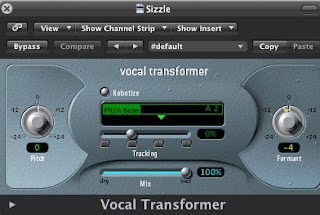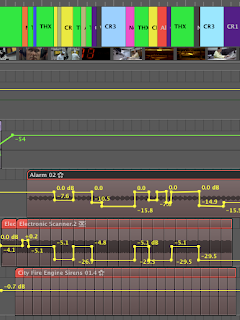Once
the mind lock takes place the camera focuses on THX and at this point the
violins join the piece. The high pitch
shrills indicate the mind lock has taken place and carnage is about to
ensue. At this point the other members
in the control rooms run off; to emphasize the point of dissonance and discord
I chose not to add footsteps so only the alarm and strings could be heard. The subtle recurring theme occurs at this
moment through the bass arpeggio. It is
heard later without the violins and choir at the very end of the piece, as THX
is being led off by the police. I chose
not to add footsteps again here so the theme could take centre stage without
any ambient or digetic sound detracting from the menace of the situation.
The
only other variation of the piece is shortly after the initial violin shrills
where a second violin part can be heard playing the same arpeggio variations as
the bass part only 3 octaves above. This
adds further dissonance and adds a pulsating feel to echo that of the alarm and
further menace to the piece.
In
film many composers have used dissonance to emphasize context and add dramatic
feel such as Bernard Herrmann in 1960’s Hitchcock classic Psycho. In Psycho the dissonant stabs of the strings
make the audience experience the brutal murder without seeing the image
graphically. In THX1138 the context is
obviously different but the approach is similar. In my video I have attempted to build up
tension gradually and then release it just as Herrmann does in Psycho.
Non-Musical Components
Sound Design and FX


Initially my first thoughts turned towards the robotic arms that THX is controlling as well as the hot metal rod that burns through the android. In order to make the movements of the arms seem real I used a sound clip of a camera shutter moving and layered it with a car sun-roof opening. This is then panned from left to right accordingly to generate a magnetization effect so the arms are followed around the screen. To get the right movements I used Logic Pro 9’s Flex-Time function to stretch the audio at specific points were the arm moves or changes direction. I found that if a piece of audio was stretched too far then artifacts would appear, however, I used one instance to my advantage as the dialogue and subsequent number sequence fitted in time. The resulting audio acts not only as the characteristic digetic sound of the mechanical arm, but also the non-digetic sound bridge in time with the numbers.
 The
next digetic sound I made was the metal rod burning through the android and
rolling to an eventual stop. The sound
of the rod was created by layered audio clips of steam and bacon frying in a
pan. I shifted the pitch of the clips
down 4 semi-tones using Vocal Transformer to give a slightly lower tone quality
to the clips. This ensured the
transformation from bacon sizzling to metal sparking.
The
next digetic sound I made was the metal rod burning through the android and
rolling to an eventual stop. The sound
of the rod was created by layered audio clips of steam and bacon frying in a
pan. I shifted the pitch of the clips
down 4 semi-tones using Vocal Transformer to give a slightly lower tone quality
to the clips. This ensured the
transformation from bacon sizzling to metal sparking.
Then using EQ I manipulated the audio clips
to sound more like there were sparks flying off the metal by removing the very
highest frequencies with a low pass filter.
In the above
manner other effects made during the clip were the electrical sparks, keyboard
typing sounds, and the metal rod rolling around the bottom of the sealed
control room. To synchronize the audio
clips with the video I used Logic’s arrange page, which involved using the
smallest divisions available to correctly align the sounds.
As
well as digetic sounds some suggestive and subliminal audio clips are also
effective in video. The first in THX-1138
is the electronic sweep that comes from an unseen computer in the CCTV room. To create this I used ES2 subtractive
synthesizer. By combining 3 triangle
waves, all pitched at different semi-tones the resulting sound thickens but
also has less musical qualities. Then by
adding a large amount of glide the result is like a computer signaling that
something is either getting faster or slower, which, is used during the
sequence where THX’s read outs are being transmitted across the intercom to
emphasize his illegal drug intake. Finally
I routed the pitch of the 3 oscillators to LFO1, which would add a vibrato
effect that subliminally suggests that something is wrong following the
dissonant sweep so is therefore an example of empathetic sound.
Similarly
other suggestive clips of audio used ES2 such as the background computer
noises. These are also triangle waves
but this time the oscillators are pitched up at various semi-tones to give a
thickened high-pitched bleep. These
along with some audio clips of hissing and air conditioning filters whirring
created the ambient sounds of the different rooms. The hissing more industrial sounds of the air
conditioning unit fit perfectly THX’s control room environment, while electronic
bleeps and tremolo printing noises work well for the control tower, booth and
CCTV room. I used different combinations
to create a unique soundscape for each room to provide continuity and overall
texture.

To make the alarm I layered 3 traditional alarm sounds and then used automation to alter the volume to give an impression of the alarm being further away or near by. Each scene has a slightly different mix to go along with the soundscape continuity. In the picture to the left the multi-colored markers at the top indicate each scene.
The
final example of sound design is the ticking clock. It has variation through the film clip and
incorporates different sounds such as the mechanical arm as a sound-bridge,
however the main theme of the clock is a slightly contrapuntal sound, due the
low bass frequencies within the sound.
The sound itself is a rhythmical drone that I stretched using flex time
to fit in time with the duration of the clock ticking. I then double tracked the result and split
the frequencies; one has exclusively a bass end and the other a treble. To the bass half (right) I added some overdrive to give a
powerful timbre and I fed the treble half (below) through a ring modulator to
modulate in time with the ticking.
Foley
Foley is the recording of sounds
that resemble the sound source. For
example a bone breaking could be the sound of snapping a carrot in half! In my
video though, the Foley design is limited to the picking up of the telephone
and the metal rod both hitting the android initially and the impact when it
melts through the second time. The
telephone sound is the recording of me flicking a PS3 game box with my TV
remote control. The result is a slightly
far away click that resembles a telephone being picked up. The first impact of the rod hitting the
android was created by dropping a beer can onto my desk. The metallic qualities and density of the rod
are consistent with the sound recorded.
Finally, the impact of the rod bursting through the android was me puffing
into my hands! The sounds were all
recorded at home using a SM57 microphone, which is a great all round
dynamic. The frequency graph details how
the response is relatively flat, yet the high frequencies are emphasized,
making it great for recording just about anything.
Vocal Dubbing
The
dialogue was recorded through SM57’s sister microphone the SM58. My parents and myself were the actors! The synchronization of the vocals was
achieved by a click track cueing up the actors to record in time. However, as the actors weren’t the original
characters it proved much harder to keep everything in time! Some of the audio is slightly asynchronous
due to this and the fact that chopping the best clips and moving them in logic
would involve taking each syllable as an individual slice. The result of this experiment was very
disjointed and inappropriate!
Once
the dialogue was recorded I fed various portion s through the vocal transformer
to change pitch and also the phase distortion to give the impression that the
vocals were sent through a dysfunctional futuristic intercom! The computer voice (‘the radiation rate is…’)
was equalized with a louder mid range to sound like it was emanating from an
unseen device in the background. The
clean vocal is given clear vococentrism to contrast with the slightly muffled
effect of the intercom and computerized voice.
This is achieved by cutting frequencies at around 1200Hz and boosting at
about 4000Hz. This makes the syllables
clearer and the vocal sit comfortably in the mix.




ReplyDeleteForum Anime Indonesia
Forum-Animeindo.comKunjungannya gan
Reccomend Anime Terbaik
Anime News
Reccomend Game Terbaik
Forum pembahasan Anime
Rekomendasi Terbaik
Forum Anime
Japan Pop Culture (Budaya Jepang)
Spoiler Manga, Anime, Game
OOT
yang unik dari jepang
Indonesia
Gamers Paling Bagus
sa564674xccc